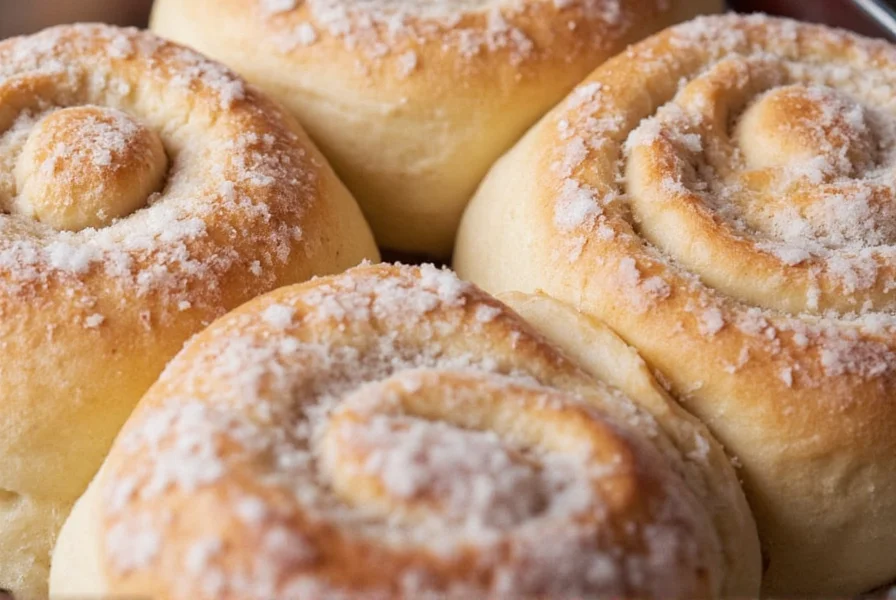Knowing when to discard cinnamon rolls is essential for food safety and preventing waste. While these sweet treats are beloved for their gooey filling and soft dough, they have a limited shelf life that requires careful monitoring. Understanding the signs of spoilage helps you make informed decisions about when to throw away cinnamon rolls rather than risking food poisoning.
How to Identify Spoiled Cinnamon Rolls
Cinnamon rolls show several clear indicators when they've gone bad. The most obvious sign is visible mold, which appears as fuzzy spots in various colors including white, green, or black. Never attempt to cut away moldy sections—mold spreads internally even when not visible on the surface.
Other warning signs include:
- Unpleasant odor - Fresh cinnamon rolls have a sweet, buttery aroma. Spoiled ones develop sour, yeasty, or generally unpleasant smells
- Texture changes - Rolls become excessively hard, dry, or develop a slimy film on the surface
- Discoloration - Significant darkening or unusual color changes in the dough or icing
- Off taste - If you take a small bite and notice sourness or bitterness (though we don't recommend tasting potentially spoiled food)
| Storage Method | Recommended Duration | Signs of Spoilage |
|---|---|---|
| Room temperature (airtight container) | 3-4 days | Mold, sour smell, hard texture |
| Refrigerated (airtight container) | 7-10 days | Slimy texture, off odors, mold |
| Frozen (properly wrapped) | 2-3 months | Freezer burn, dry texture, off flavors |
Proper Storage to Extend Freshness
Before you need to discard cinnamon rolls, proper storage can significantly extend their shelf life. For short-term storage, keep them in an airtight container at room temperature away from direct sunlight. Adding a slice of bread to the container can help maintain moisture.
For longer storage, refrigeration is recommended. Wrap individual rolls tightly in plastic wrap, then place them in a resealable container. When properly stored this way, refrigerated cinnamon rolls maintain quality for up to 10 days.
Freezing provides the longest preservation. Wrap each roll individually in plastic wrap, then place them in a freezer bag with as much air removed as possible. Properly frozen cinnamon rolls stay fresh for 2-3 months. Thaw overnight in the refrigerator before reheating.
Creative Ways to Use Stale Cinnamon Rolls Before Discarding
When your cinnamon rolls are getting stale but haven't yet spoiled, several creative recipes can give them new life before you need to discard cinnamon rolls:
- Cinnamon roll bread pudding - Cube stale rolls and use them in place of regular bread for a decadent dessert
- Cinnamon roll French toast - Soak slightly stale rolls in egg mixture for a breakfast upgrade
- Crumble topping - Crumble stale rolls over ice cream or fruit crisp
- Trifle layers - Use in place of cake layers in dessert trifles
- Reheat with moisture - Sprinkle with water and microwave briefly to restore softness
These methods work best when rolls are merely stale but still within their safe consumption window—never attempt to revive rolls showing signs of mold or spoilage.
Safe Disposal Methods for Cinnamon Rolls
When you've determined it's time to discard cinnamon rolls, proper disposal matters for both hygiene and environmental reasons. Never pour icing or fillings down drains as they can cause clogs. Instead:
- Place spoiled cinnamon rolls in a sealed plastic bag before putting them in your regular trash
- Consider composting plain, unfrosted rolls without dairy-based icing (check local regulations)
- Never feed moldy baked goods to pets or wildlife—they can cause serious health issues
- If disposing of large quantities, wrap securely to prevent attracting pests
Food Safety Risks of Consuming Spoiled Cinnamon Rolls
Eating cinnamon rolls past their prime isn't just unpleasant—it can cause foodborne illness. The moist environment of the dough and icing creates ideal conditions for bacteria like Staphylococcus aureus and mold that produce harmful mycotoxins.
Symptoms of food poisoning from spoiled baked goods include:
- Nausea and vomiting within 30 minutes to 8 hours
- Diarrhea and abdominal cramps
- Fever in severe cases
- Dehydration from fluid loss
Vulnerable populations including young children, elderly individuals, pregnant women, and those with compromised immune systems face higher risks from consuming spoiled cinnamon rolls. When in doubt about whether to discard cinnamon rolls, follow the food safety adage: "When uncertain, throw it out."
Preventing Cinnamon Roll Waste
To minimize how often you need to discard cinnamon rolls, consider these prevention strategies:
- Bake in smaller batches if you won't consume them quickly
- Freeze rolls immediately after baking for future use
- Store icing separately from rolls to extend freshness
- Mark storage dates clearly on containers
- Monitor rolls daily for early signs of spoilage
Understanding proper storage techniques and recognizing early spoilage indicators helps reduce food waste while keeping your family safe. Remember that the shelf life of homemade cinnamon rolls differs from store-bought varieties due to preservatives in commercial products.

When to Consult Food Safety Experts
If you're uncertain whether your cinnamon rolls are still safe to eat, consult official food safety resources rather than risking illness. The USDA FoodKeeper app provides specific guidance for various food items, including baked goods. Local cooperative extension offices also offer free food safety advice from certified experts.

Frequently Asked Questions
Can you eat cinnamon rolls after the expiration date?
Expiration dates on store-bought cinnamon rolls indicate peak quality, not safety. You can eat them after this date if they show no signs of spoilage and have been properly stored. Homemade rolls without preservatives have shorter shelf lives than commercial products. Always check for mold, off odors, or texture changes before consuming.
What happens if you eat spoiled cinnamon rolls?
Consuming spoiled cinnamon rolls can cause food poisoning with symptoms including nausea, vomiting, diarrhea, and abdominal cramps. Moldy foods may contain mycotoxins that can cause more severe reactions, especially in sensitive individuals. Symptoms typically appear within 30 minutes to 8 hours after consumption. Seek medical attention if symptoms are severe or persist beyond 24 hours.
How can you tell if refrigerated cinnamon rolls have gone bad?
Refrigerated cinnamon rolls that have spoiled will often develop a slimy texture, sour or unpleasant odor, or visible mold. While refrigeration extends freshness, it doesn't prevent spoilage indefinitely. Check rolls daily for these signs, especially after the 7-day mark. Properly stored refrigerated rolls should remain safe for 7-10 days, but always inspect before consuming.
Can you freeze cinnamon rolls to prevent having to discard them?
Yes, freezing is the most effective method to extend cinnamon roll shelf life and prevent waste. Wrap individual rolls tightly in plastic wrap, then place in a freezer bag with air removed. Properly frozen rolls maintain quality for 2-3 months. Thaw overnight in the refrigerator before reheating. Never refreeze thawed rolls, as this compromises both texture and safety.
Do cinnamon rolls with cream cheese frosting spoil faster?
Yes, cinnamon rolls with cream cheese frosting have a shorter shelf life than unfrosted varieties. The dairy content in cream cheese frosting accelerates spoilage. Unfrosted rolls last 3-4 days at room temperature, while frosted versions should be consumed within 2-3 days. Refrigeration extends frosted roll freshness to 5-7 days. Always store frosted rolls in airtight containers to prevent the frosting from absorbing other refrigerator odors.











 浙公网安备
33010002000092号
浙公网安备
33010002000092号 浙B2-20120091-4
浙B2-20120091-4